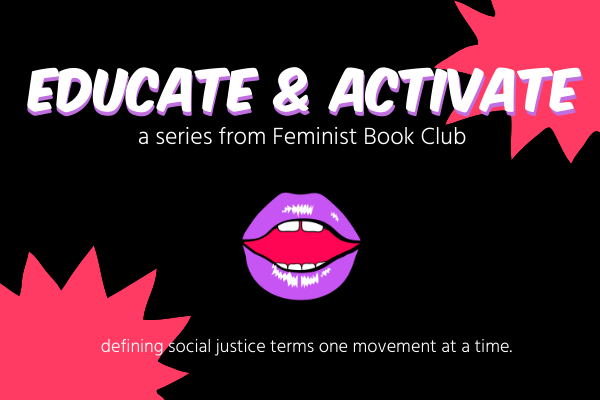Feminist Book Club blog contributors are working together to create posts in an “Educate & Activate” series. We will define a term or movement, provide historical context, and give you additional resources to learn more. We believe that an educated populace makes for better activists, accomplices and co-conspirators. It is important to note that these are meant to be brief descriptions and not inclusive, or exhaustive, of all resources. We urge you to continue being curious, and continue learning more.
Definition
Ally – someone who is not like you and does not suffer the same oppressions, but who supports your struggle for rights and freedom.
Accomplice – “…[people who] fight back or forward, together, becoming complicit in a struggle towards liberation. Accomplices are realized through mutual consent and build trust. They don’t just have our backs, they are at our side, or in their own spaces confronting and unsettling colonialism.”
First Usage
Ally – 1598 in the “we’re political allies” sense. The first printed use of the term “ally” in the way we’re discussing was in “Beyond Tolerance: Gays, Lesbians, and Bisexuals on Campus”, a 1991 resource manual published by the American College Personnel Association.
Accomplice – 1584 in the “we going to jail together” sense. The idea of an accomplice in activism was first introduced in May 2014in Indigenous Action via “Accomplices not Allies: Abolishing the Ally Industrial Complex”.
History
The idea of an allyship began in the early 1990s. American College Personnel Association published a manual that aimed to discuss the taboo subject of prejudice and oppression based on sexual orientation. This was less discussed at the time compared to the prejudice and oppression based on race. One of the last chapters was titled “Becoming an Ally” and suggests the self-actualizing “heterosexual ally” was the same in development and values to the white advocate for anti-racism. They took folks through 5 steps to becoming an ally and made clear that the hardest part of being an ally for LGBT rights would be the possibility that any ally would be mistaken for someone who was LGBT.
This was a big concern for people at the time, and a departure from anti-racism work because if you were white, you couldn’t be mistaken for a Black person (insert Rachel Dolezal meme here). So, the authors of the Beyond Tolerance manual stressed that “…only the the most self-aware, secure heterosexuals can become allies” and then they, weirdly, made a list of reasons to become an ally, which consisted of things that exclusively benefited the ally. Examples include:
- – Feeling less constrained by dominant sex and gender roles!
- – Be invited to some of the most fun parties!
- – Play some of the best sports!
- – …and other sundry items that only gay and lesbian people are good at!
Allies were given equal footing as the identity group that they were trying to support and, in some cases, were positioned as those who assisted people of color because they needed assistance, thereby maintaining oppressive hierarchies.
Moving into the 21st century, social justice education initiatives broke the mold of a white, cis-, hetero- ally with the embrace of intersectionality. The ally of the 90s became “social justice allies” of the 00s who acknowledged the intersecting identities, oppressions, and conditions between allies and the diverse communities that they sought to support and/or align themselves with. However, the work of allies was the same even with the introduction of intersectionality. An ally stood with the community that was oppressed, while having equal, and in some cases more footing due to the ally directing the activism taking place.
If these terms were Pokémon, ally is the baby Pokémon; the Charmander if you will. It’s a good starter buddy to help you when you begin your journey. Accomplices are the next evolution – Charmeleon.
To become an accomplice, you have to gain enough experience, level up, and realize that you cannot just stand with the group you support. You have to be complicit in dismantling the systems or structures that oppress the individual or community that you support and – more than that – you must recognize that the work has to be directed by the leaders you’re working with and are willing to take risks to do the work necessary.
The $64,000 question being discussed by academics now is do we need both allies and accomplices in social justice work? Is one better than the other?
I’m not sure of the answer, but below are some resources to help you continue learning more about both.
Resources for Further Education
Reclaiming our Space by Feminista Jones
Becoming An Ally: Breaking the Cycle of Oppression by Anne Bishop
How to Tell the Difference Between Real Solidarity and ‘Ally Theater’ by Mia McKenzie
Opportunities for White People in the Fight For Racial Justice
Ally is not a Noun by Lona Davenport
We Don’t Need Racial Equity Allies; We Need Active Accomplices by Joy Alise Davis
Allyship (& Accomplice): The What, Why, and How by Michelle Kim
Holy Shit! Being an ally isn’t about me! by Real Talk WOC & Allies
Save the Tears: White Women’s Guide by Tatiana Mac


